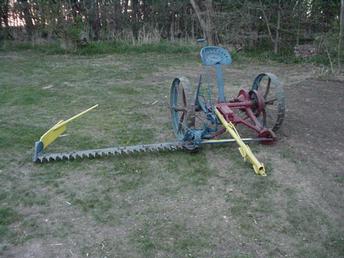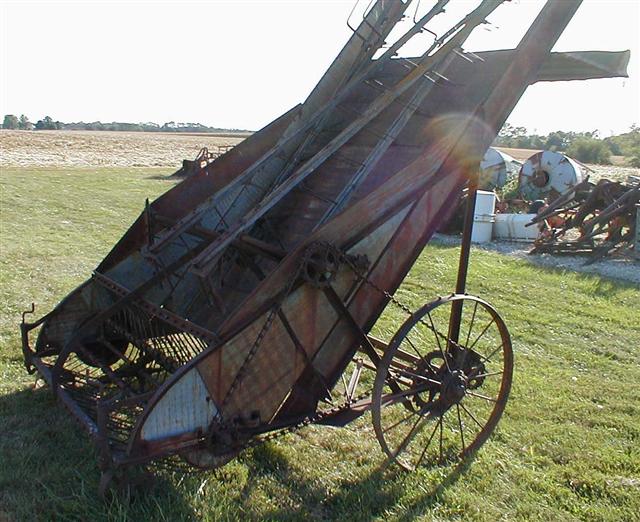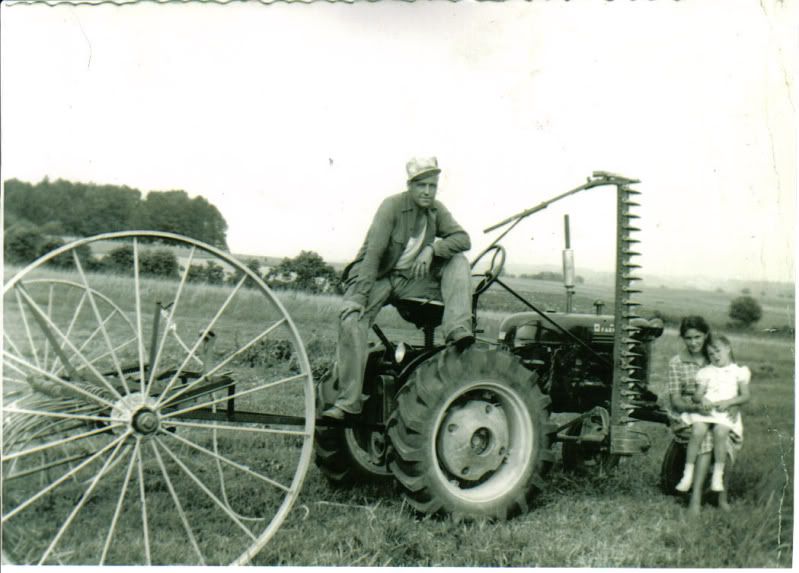Page 1 of 2
Loose Hay (long post)
Posted: Fri Aug 24, 2012 12:31 pm
by v w
After seeing Rudi's post today which had a picture of hay trollys I thought I would put together how loose hay was put up. I have only a general knowledge so not much detail.

An old horse drawn mower. Picture from tractorshed.

After mowing the hay was raked into windrows. The hay was gathered by the tines until the operator "dumped" them inline with the other dumps to form a windrow. Hence the name dump rake. picture from wikipedia

The hay loader was drawn behind the wagon and lifted the hay from the windrow onto the wagon. This loader pushes the hay by alternating the movement of the bars to push the hay up. Other styles used crossbars much like a manure spreader. A man rode the wagon to spread the hay. This was somewhat of an art to load so as not to have the load slide off. picture from chattractor



The hay was placed in the barn by a large fork running on a rail in the top of the barn. The trolley part is shown in the top picture while two stabber type of forks are shown in the second, the third is a grappling style. There was also a sling type which had to be placed on the wagon prior to loading. Think large tarp with spaces for hooks. The forks were pushed into the hay to lift a large amount from the wagon. A rope led from the forks, thru the trolly and to the end of the barn and then thru a series of blocks and attached to a horse. When the horse was driven forward the hay would be pulled up to the trolley then along the rail to where it was wanted, the trip rope pulled to dump the forks and as the horse was reversed the trip rope was used to pull the trolly back over the wagon. This was repeaded until the hay was off loaded.

The hay once in the mow exerted a lot of pressure on the hay and the bottom was compressed as tight as if it had been baled. Hay knives were used to cut chunks from the mow to use for feed. picture from americiaanartifacts
Vern
Re: Loose Hay (long post)
Posted: Fri Aug 24, 2012 12:55 pm
by John *.?-!.* cub owner
Most people did not have the fancy hay loader. The dump rake was used to put the hay in piles and then the piles were then either loaded by hand or if you had a hay buck on a tractor that could be used.
Re: Loose Hay (long post)
Posted: Fri Aug 24, 2012 1:09 pm
by Bob Perry
When I was a little boy, all those things, like the hay loader, and the dump rake, were around like they had been used yesterday, I think they got the first baler in '56 when I was 3.
Re: Loose Hay (long post)
Posted: Fri Aug 24, 2012 3:47 pm
by OliverFarmall
My cousin who only did loose hay up into the early 1970's , he's in his 80's now... was telling me about doing loose, hay from field windrows forked into the wagon, and "walked in" (packed) by kids walking on it. He also said about salting it to dry it.
Re: Loose Hay (long post)
Posted: Fri Aug 24, 2012 4:40 pm
by ScottyD'sdad
My father put up loose hay, mowed with a cub, raked with a dump rake, for years. Picked up by pitchfork, loaded on to a wagon, and Forked into the loft. When a neighbor bought a baler, he hired him to bale it. We still raked, with the dump rake. Ed
Re: Loose Hay (long post)
Posted: Fri Aug 24, 2012 4:48 pm
by v w
John *.?-!.* cub owner wrote:Most people did not have the fancy hay loader. The dump rake was used to put the hay in piles and then the piles were then either loaded by hand or if you had a hay buck on a tractor that could be used.
There were many ways I'm sure of handling loose hay. As tractors became fairly common I understand hay was gathered on buck rakes and taken to the barn without being windrowed, but not in this area. Loose hay is just a bit before any clear memory for me. Today I can still claim age 71. By the late 1940's my uncle had a baler and that is the first I really remember. I don't ever remember seeing hay cocks here, most every farmer had a loader or may have even traded labor with a neighbor who had one. Quite a lot of such was done. Any old barn I was ever in had a trolly in the peak. It may have to do with the size of the farms. By 1950 consolidation of farms and increasing size of equipment had begun with the average farmer owning/renting about 180 acres. Today what used to be a farm is now a field. Vern
Re: Loose Hay (long post)
Posted: Fri Aug 24, 2012 7:13 pm
by Rudi
I am fortunate to have Em's Great Grandfather's IH Hay Rake and his Frost and Wood sickle bar mower. Although his mower will eventually just be restored yard art, I was lucky enough to get a free working F&W mower from my friend Dale McKay in Debert. I plan to eventually use the Hay Rake on my upper fields. Probably will all be loose hay though as I don't think I can afford even a small baler

Re: Loose Hay (long post)
Posted: Fri Aug 24, 2012 8:13 pm
by Ike
I never helped with loose hay, but we used a grapple fork to put hay and straw bales in the mow six bales at a time. When I started helping, I was too little to handle the bales, so I got to drive the tractor pulling the rope.


When I got older, I managed to keep that job.

Ike
Re: Loose Hay (long post)
Posted: Sat Aug 25, 2012 8:16 am
by Bill
I remember some hay wagons had a few center boards missing so the harpoon could grab the lower hay on the wagon. All this was done with horses, long time ago.
Bill
Re: Loose Hay (long post)not always a 'free ride'
Posted: Sun Aug 26, 2012 11:44 am
by Ida Red
When we did loose hay up in Burgessville, we used the sicklebar mower, a hay rake and a hay loader. Following the hay loader was a flat rack wagon which had a trolley deck on half of it. When this deck was loaded from behind the hay loader this trolley was rolled to the back of the wagon and then you loaded the front half of the wagon and headed for the barn. You then headed up the barn-bridge hill with the team and stopped on the barn floor,below the hay fork which was lowered from high above, in between the 2 hay mows. The hay fork was then lowered, punched into the wagon hay pile and the fork trigger locks put on. A heavy attached rope pulled the load to the roof of the barn using a system of pulleys, by a horse outside on the ground. When the fork load of hay was locked into the trolley at roof level it would change directions and continue to be pulled down the track. When you got the hay pile where you wanted it, high above the mow you could then get the hay swinging and let it drop more precisely, to the mow and save a lot of work levelling out the mow because mowing was a terrible, hot job.
I remember one particular ride on a load of hay up into the barn. On the load behind a team of horses, just as we reached the top of the barn bridge hill, both whipple trees behind the horses broke and let the wagon go full speed backwards, free-wheeling down the hill... crashing into a bunch of trees. No one was hurt and only the back of the flat rack wagon had to be fixed and a new set of whipple trees put into use... but that was the best 'free ride' that we ever had.
Re: Loose Hay (long post)
Posted: Sun Aug 26, 2012 1:09 pm
by beaconlight
I never worked loose hay but we used to put bails into an old loose hay barn. The trolley and all the rest of the stuff was still there but not used. We did use an elevator to bring the bails into the hay loft and had to spread them by hand with hay hooks. We fount the larger log hooks worked better. Al Cobb the farmer always put salt on every layer of hay we put up. If the moisture seemed high to him we put more salt on so it didn't heat up and start a barn fire.
We could never put more than one bail on the elevator at a time. I asked him why not? Al said it blew a fuse if you did. He had an old dairy barn. Al had sold the milk cows after his oldest son had got killed by lightning while attempting to straighten a load of hay that started to shift on the way from the field to the barn. He had 465 beef and over 100 horses and pony's at the time I worked with him. One day I was in the barn and heard the gutter cleaner trying to work as hay was being lifted to my son Bill. After a bit I determined that one side of the 220V was blown in the house and the 110V hay elevator was working through the 220V gutter cleaner. We replace the fuse and then you could send any number of bails up the elevator at one time that you wanted to.
Al brokered hay at the time and all his customers marveled the their animals ate his hay more readily than that the obtained from others. The salt was the reason I believe.
One time late in the year when Poplars ( Aspen) were shedding leaves we bailed a lot of leaves with the Timothy. Al included a bail or two with each truck load as an extra. of course we put salt on the bails. Al had customers asking for those with the leaves for the fed out well. Hey you never know. This thread brings back many happy memories of working with my kids.
Another time on New Years eve Al my son Bill and I delivered a load of Hay to a farm near Ithaca NY. It was snowing quite hard as we neared the farm we were to deliver to. As Al turned in to the road to the farm the truck started to slide so he straightened out and we went through town before we could stop. We turned around and made it ok coming up hill into the turn. We unloaded and stacked the hay in the barn. As we were leaving the farmer started to hitch up a horse and wagon to take boarders on a ride. My son Bill noticed that the farmer hadn't kneed the horse in the belly to tighten the synch. He made a comment and the farmer said what would a city kid like you know. Al Bellowed out " Best listen to the boy, I taught him" Al had farmed with horses and the farmer knew it. He just walked out of the barn and let Bill finish up harnessing and take the people for the ride. When we got into the truck Bill told us about the boarders from the Bronx talking between them selves about the country bumpkin driving the sled. He didn't have the heart to tell them that he was from NYC too( Staten Island)
I miss Al for he is long deceased.
Re: Loose Hay (long post)
Posted: Sun Aug 26, 2012 5:21 pm
by Dusti Snider
Poppy raked his hay loose for years. When my Mom was a little girl Poppy raked it up in windrows, put in shocks and drug the shocks to the stack that he built in the field. When I was a little boy Poppy had started having some of it bailed by a share cropper, but we still put up one large field worth loose. We stacked it on a wagon and hauled it to the barn then threw it in the loft with pitch forks...

Re: Loose Hay (long post)
Posted: Mon Aug 27, 2012 7:53 am
by Gary Dotson
We made loose hay until the mid sixties. We were only slightly more modern than some of the previous posts. We used a ground driven John Deere mower, early on, later updating to a semi-mounted IH mower on the H. We used an old side delivery IH hay rake and a New Idea hay loader. At the barn, we used our F-12 on the hay rope, pulling the grapple style forks. Even after switching to a baler, we continued to use the forks, later acquiring an elevator. I think making loose hay was probably the most dreaded job on the farm. Fond memories, I suppose, just glad they are memories.
Re: Loose Hay (long post)
Posted: Mon Aug 27, 2012 8:12 am
by Rudi
Re: Loose Hay (long post)
Posted: Tue Aug 28, 2012 1:21 pm
by Bus Driver
My grandfather had the hay fork and trolley in his barn and I saw it in use several times. The first baler I ever saw was a stationary wire baler. Hay was forked from the wagon into the baler which was parked at the barn. I have ridden a dump rake when that was all that we had. Rakes progressed to the side delivery type from the dump rake. Balers progressed to the "pickup" type, still wire type, as I called it and then to the string tie type. Handling the wire tied bales often required the use of gloves. And cows could be seriously harmed by swallowing the short pieces of wire often trapped in the bale as the tying mechanism snipped off a short piece of wire in the tying process.














